
Friday 12th January 2007 Off to Ecuador
The alarm went at 5.00 am but we were already awake.
The taxi driver arrived early, so we had to wait at Savacentre for about 20 minutes. It was still dark, but dry and mild.
We dozed on the coach trip to Heathrow, waking a bit startled when the driver took a different route!
We had no problems at the airport, apart from the tedious extra baggage checks, particularly the recent restrictions on taking liquids. We were glad of the sandwiches I had made up, after our early start.
We had a trouble free flight to Miami, although the plane was full with excited holidaymakers. There were no good films to watch, and after leaving the clouds of England, the flight was all over the sea until we descended to Miami. Because of this, or perhaps because we had had a very busy Christmas, with all our children being at Elm Gable for part of the time, we slept for much of the way. The main meal was yuk, although the snack served just before our descent was OK.
We had a couple of hours to wait at Miami, and noticed how pleasant the officials appeared to be. The onward flight was much less crowded, and the meal wasn’t bad, but we were disappointed to ascend immediately into cloud, so couldn’t see any of the scenery. It then soon became dark, but we were able to see what we thought was Panama City all lit up.
The descent to Quito was quite spectacular – we skimmed over the rooftops of this vast city nestling amongst the Andean volcanic peaks arriving just before 9 p.m. (or 2 o’clock in the morning!).
We collected our luggage (we had had to collect it and then leave it again at Miami, so had hoped that it would arrive), and were immediately met by our ‘Explore’ representative and driver, who cheerily transported us through Quito’s city streets to the grand ‘Hotel Quito’, where we will be spending the next 3 nights.
Everyone seemed very pleasant as we booked in and were taken to our room. We were intending to go straight to bed, but as we had been given vouchers for a free drink, we made our weary way up to the 7th floor, where we enjoyed a rum sour/rum and coke with views out to the lights of Quito and Mt Pichincha.
The musician had just started up when we called it a (long) day and made our way back to our room it was 11 p.m., but 4.00 a.m. to us, and we had woken 24 hours ago.
Saturday 13th January Catching up in Quito
We were glad to have this ‘lazy, catching up’ day, before the tour starts tomorrow. Despite dozing a lot yesterday, we both slept pretty well, getting up at about 7 o’clock local time, and making our way up to the restaurant for breakfast. I’m not sure which was the most impressive – the wonderful choice of food for breakfast, or the breathtaking view! We enjoyed both, but the sight of the mist in the valleys, and the astonishing city set amongst the stunning mountain scenery was something to be remembered! My camera started its work!
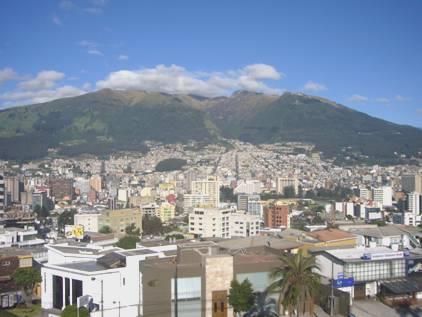
View of Quito and Pinchincha volcano from our hotel
Afterwards we wandered around the grounds with its lovely gardens with heliotrope, agapanthus, busy lizzies and much more. We located the very pleasant swimming pool, and returned to it a bit later on for a swim and short laze in the warm sun. We were both feeling pretty knocked out, and blamed it on the altitude (8900ft or 2700m). We were really glad to have this extra day, and hope that we will feel more energetic tomorrow.
Towards lunchtime we walked out and found a nearby restaurant where we sat outside under shade, with a view through greenery to part of the city and mountains beyond. We both had soup – mine an Ecuadorian potato soup, and Adrian’s apparently beef soup, without any beef! We drank an Ecuadorian beer each, and soaked up the atmosphere. We were given savoury pop corn as ‘tapas’. We walked back to our room past a viewpoint down over one of the valleys. It was hot.
In the afternoon we walked out into the ‘new town’, heading for the street called Amazonas, where it is all supposed to happen. We had read that shops were mostly closed on a Saturday afternoon, and this was true, so it wasn’t very vibrant. We turned off into a narrow street full of bars, where mostly young people were sitting drinking beer. The only other people about were the street cleaners, who were busily going about their work.
We had only just got back when Diego, our tour leader, phoned and asked how we had been getting on. He planned to arrive with the rest of the group later on, and would then hold a meeting.
We decided to eat first, so at about 6 o’clock we crossed the road to ‘Hunters’, adjacent to where we had eaten lunch. We were pleased to be able to get a glass of house wine cheaply, which went well with our sea bass (A) and shrimps (huge prawns – R). We’d had salad and French bread first, so couldn’t finish it all.
We returned to the hotel, and at around 7.30 the rest of the group arrived in the lobby. To our relief they were all of a similar age to us, and not a group of 18 year olds! Most were ready to go off to their rooms, but after making ourselves known to Diego, 7 of us returned to Hunters, where we all had a beer, and the others had soup. Two couples – Roger and Janet from Harpenden, and Ron and Diana from near Aldeburgh, had been holidaying together since the late 70s. The other person was Mary from Victoria, Vancouver Island. After much chat, we returned to our room for an early night.
Sunday 14th January Exploring Quito
After another superb breakfast with the stunning views, we all met up at 8.30 for our introductory briefing. Diego gave us detailed accounts of our itinerary, which got us all excited. Everyone introduced themselves – a pleasant lot, and all, it seems with an interest in wildlife.
There was only time to dash to our room to make sure we had all we needed for the day, before our 10.30 departure by bus to explore Quito. Our driver is called Danilo (Danny) – a large but genial looking chap.
Our first stop was at the Mirador de Guapulo, just behind the hotel, which we had walked to yesterday. Diego told us much about Quito, and the valley that we were looking down into. It appears that there is a big industry of rose growing in the valley – the hotel has spectacular rose displays in the lobby.
There was a monument to a conquistador called Orilliana who set off from this point to search for cinnamon, but instead came across the Amazon River.
Ecuador has a population of 12 million, 40% of whom are under 20.
60% are mestizo (Indian/Spanish), 25% are ethnic and 5% are immigrant – Lebanese, Chinese and Italian. The population of Quito is 1.6 million.
The city of Quito spreads along the valley for 45 km, but is only 6-8 km wide.
The bus took us to the top of Panecillo Hill, where there is a huge statue of ‘Our Lady of Quito’. From here there was a wonderful view down over the city, and to the volcano of Pinchincha which overlooks it. To the south we could see the vast volcano of Cotopaxi in the distance.
We bought some banana ‘crisps’, which kept us going until our late lunch.
Ecuador is apparently self sufficient, importing only luxury items. Its biggest export is oil, from the Amazon area, followed by bananas and then tourism.
Our driver dropped us in the ‘old town’ where Diego showed us around many of the sights. Being Sunday, people were out everywhere enjoying themselves. The atmosphere was more festive than usual, as the new president, Rafael Correa, is being inaugurated tomorrow. A lot of children were waving flags, and the police were out in force, especially by the hotels where Ecuadorian and foreign dignitaries are staying.
We looked inside San Francisco church, where a service is held continually. There was the original ‘our lady of Quito’ statue and a famous one of Christ. Outside we spoke to a group of strolling players from Peru, who were dressed in ancient costumes like men we had seen in Mexico.
We saw many other churches – there are 25 special ones in Quito, but the supposedly most beautiful one was closed this afternoon for some unknown reason. We spent some time in the main square, flanked by attractive buildings, including the President’s palace. The square looked very Spanish, and was full of flowers and trees.
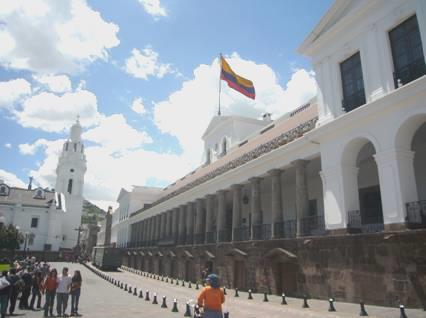
The president’s palace – ready for tomorrow’s inauguration
There was a street performer nearby who made a thing of following tourists down the street and mimicking their walk.
We had survived the heat and the altitude well, and at 2 o’clock were driven back to the hotel, where, 10 minutes later a group of us left in the bus to be dropped at the Botanical gardens. The first thing we did was to make our way to the food kiosk, which didn’t serve much, but we were able to get the last 2 ‘pasties’. We then had a pleasant wander around the restful and cooling gardens, including a walk through the orchid greenhouse. It felt a bit like being at Kew - especially with the planes right overhead coming in to land. Diego had told us this morning that they are building a new airport in the next valley to be opened in 2009, as the present one is now considered too dangerous, right in the middle of the city.
We wandered back through the Parque la Carolina, then we got a taxi back – some of the others walked, but we felt that it was money well spent, as it was all uphill.
Back at the hotel, we called in briefly to use the internet, then made our way down for a hasty swim before coming up to our room to get organised for this evening and tomorrow.
At 7.30 we left in 2 taxis with 2 other couples – Carol and Doug from Reno and Diana and Clive from Rochester, for la Ronda. This was a very attractive Colonial restaurant where the tables were set up as if for a wedding, with pink and white cloths and wide pink sashes around the white covered chairs. We were handed enormous menus, but were relieved to see that the prices weren’t high. The food was nice, but what we had come for was the entertainment. First there was a group of minstrels – six men who each played a variety of instruments – sometimes 2 instruments together! Pan pipes, drums, recorders, guitars, rattles. They played the music directly to us at the tables – typical Andean music, and really vibrant. After them, the dancers came on – about half a dozen girls and chaps. They performed several different dances – each in different costumes. It was very colourful and energetic, and they seemed to be really enjoying themselves. A little boy joined in a couple of the dances – skipping round and round in costume and mask. Altogether a really good evening.
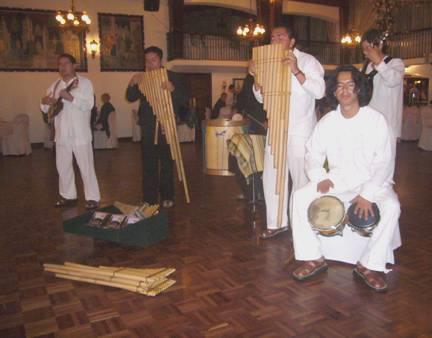
Pan pipes, guitar and drums
Monday 15th January Delightful humming birds and orchids in the cloud forest.
Another lovely morning, and a superb breakfast with our fantastic view.
We left on the bus at 8.30, driving through Quito, where it was very busy outside the hotel where dignitaries were staying for today’s inauguration of the new president. We stopped by the office for Diego to call in, which gave us a chance to buy a large bottle of water, and to stand chatting in the warm sunshine.
We were driving north west today, to a cloud forest region, and while we made our way out of busy Quito, Diego continued giving us the benefit of his wide knowledge.
Primary education is compulsory in Ecuador, but not secondary education. In fact 10% of children do not go to school at all. Many Ecuadorians have emigrated in recent years to find work, but send money back to their families who still live here.
We drove north out of Quito (actual name San Francisco de Quito), and passed the ‘Centre of the world’, which we will be stopping at tomorrow. Just past here we turned off to Pululahua volcano – there are 55 volcanoes in Ecuador, 12 of them active. This one is a dry volcano, and not active. Way down inside it are flat cultivated fields, growing maize, and scattered farm houses. We were lucky to be able to visit it, as the ‘president and his men’ were coming later today to have lunch at the restaurant overlooking the crater.

Looking down into Pululahua volcano
We now descended to the cloud forest, which lies between 4,000 and 8,000 feet. It is called cloud forest as it gets most of its moisture from the cloud which arrives by midday. Most days there is light rain for about one hour each afternoon, and again at night.
At 6,000ft we stopped at Pahuma orchid reserve, where we wandered through the damp forest, viewing dozens of orchids, many of them with really tiny flowers. The path was quite rough and muddy – I was glad of my hiking stick, but marvelled at the fact that nobody else found the going difficult. We walked as far as a pretty waterfall, and as we returned we saw humming birds, and a trogon.
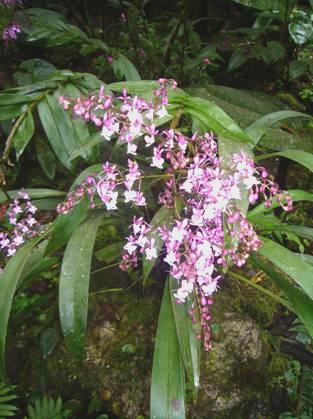
One of the many lovely orchids
Now we made our way to Mindo, at 4,000ft. This has become a place to ‘get away from it all’ and enjoy nature. We had to drive several kilometres down an unsurfaced, muddy track to the lodge where we are staying tonight. Once there, we were served a delicious 3 course meal – pancake with palm of hearts; chicken with mashed potato and tomato, then swiss roll. I drank ‘tree tomato juice’, which tasted exotically nice.
It was a lovely setting. Now we had to walk some distance through the forest to the house where we are staying – a rustic building, ours accommodating 3 couples. We had just time to view our delightful room, before setting off once more.
As it was still rather damp, we left the butterfly farm visit for tomorrow, and headed by bus to a small café, where humming bird feeders were set up. We spent a long time sitting on the balcony and watching dozens of these tiny birds. There were lots of different varieties –the long tailed one really took our fancy, and doesn’t always visit. There was also the tiniest humming bird in Ecuador.
After soaking up this lovely atmosphere, we were driven back, but stopped some way before our lodge so that we could walk back along the track. We saw several birds at the start, including a yellow-rumped tanager, then it was just pleasant walking along in the twilight, enjoying the sights and the sounds.
Some of the other birds we saw this afternoon were a black phoebe and a hornero, which was an orangey colour, and which I had seen first from the bus.
We walked over through the forest to the lodge for our evening meal of soup, tilapia fish and chocolate cake. Feeling very full we came back through the forest to prepare for our 5.30 start tomorrow.
Tuesday 16th January Birds and butterflies and the centre of the earth
At 6 o’clock a silent line of people ascended the steep and muddy path through the cloudforest to come out on the track at the top. Over three hours later we arrived back at the lodge, feeling that we had deserved our breakfast!
We had seen quite a lot of birds, the most impressive being a group of swallow tailed kites – both flying and perched.
Other birds we saw included a golden tanager
Ruddy pigeon
Ornate flycatcher (yellow)
Smooth billed ani
Tropical king bird
Blue and white swallow
Blue grey tanager
Orange bellied euphonia
We left the lodge at 10.45, stopping just along the road at a butterfly farm. This was a lovely visit, as the butterflies were superb, and the lady was very informed, and showed us the eggs, caterpillars, pupae and emerging butterflies.
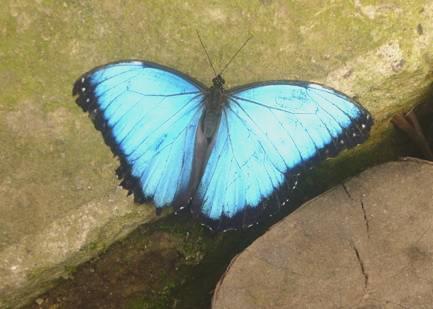
Beautiful morpho butterfly
We dozed as we were driven back to Quito, where the change from the luxuriant cloudforest to the dry valley was dramatic. Today’s journey included two passes over 3000m.
We stopped at a small museum by the ‘centre of the earth’, where Diego showed us around some ancient Indian homes – one including guinea pigs, which have always been kept as a food source in Ecuador. We also saw llamas. In another place we were shown an actual shrunken head. We had a demonstration of ‘the water going down the plughole’, then left to have lunch in a smart restaurant nearby. I had salad and passion fruit juice and Adrian had Ecuador soup with a beer. Then it was time to visit the ‘mitad del Mundo’ – the centre of the earth, where we got an official stamp in our passports, and had a group photo taken. We bought some stamps and postcards before leaving for the 90 km drive to Otavalo.
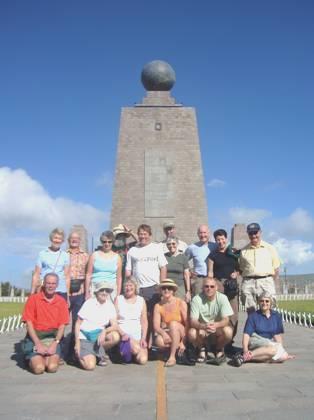
Our group at the ‘centre of the world’
This was initially on the Pan American Highway, which actually runs for 1000km through Ecuador from Colombia to Peru.
We passed some dramatic scenery as we drove from Pinchincha Province to Otavalo Province, arriving at our hotel in the town of Otavalo at 6.10.
There was only time for a quick shower before our 7 o’clock briefing, after which we all walked along to a nearby Sicilian restaurant to eat pizza for supper.
Wednesday 17th January A lovely crater lake and a colourful market
We left on the bus at 7.45, heading for Cuicocha crater lake. We had lovely views of the 2 mountains we had seen yesterday – Cotacachi and Imbambula (4,600m). We passed some traditionally dressed ladies, with their pretty embroidered white blouses, long black skirts and ‘head dresses’, which looked more like a bag placed on their head! Some were carrying babies tied to their backs, and others were carrying wood.
The traditional clothes for men are white trousers, poncho and felt hat. Both sexes have long black hair.
Our walk around part of Cuicocha Lake in Cayapas reserve was really delightful. The lake looked turquoise and there were wild flowers everywhere – bidens (small yellow and some pink dainty flowers), calceolaria, a sort of Indian paintbrush, tiny lupins and a wonderful magenta coloured orchid, to name just some. It was beautifully warm. We saw a few birds – brown bellied swallows, a great thrush, American kestrels and an Andean coot, but not the condor we had hoped for!
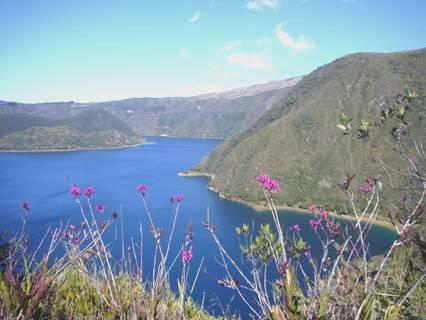
An colourful orchid enhances Cuicocha Lake
We were driven back to Otavalo, where we made our way to the market and made several purchases – 2 pairs of stripy trousers, a panama hat each (they are made in Ecuador, not Panama), an alpaca sweater for me, a T shirt for Adrian, and later, in the other market, a watch for me, as mine had stopped the other day, and we didn’t expect to find a battery here.
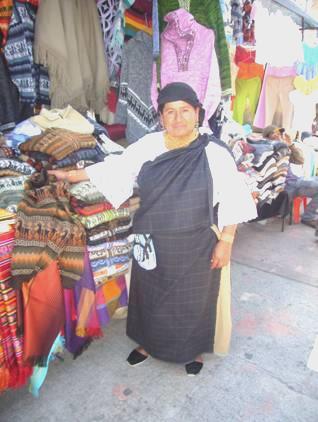
In Otavalo Market
At one o’clock we left on the bus, stopping soon at Peguche village, where we had lunch at a family home – corn on the cob, potatoes, another related root crop, avocado, beans, roast corn kernels, cheese and – guinea pig! Well, I tried just a tiny bit. Fresh pineapple was for afters. We were then shown how pan pipes were made, and we later bought some.
Next two of the young girls danced for us, and then we listened to some Andean music. The star of the group was a little tot of scarcely 2 years, who stood with the 2 older girls and shook her sheep’s hoof rattle! We spoke to many members of the family, and bought other items, including a CD of their music, which we listened to in the bus later. [When we got home, we discovered, as I had thought, that we had a cassette bought in England in the 80s of the same family group!]
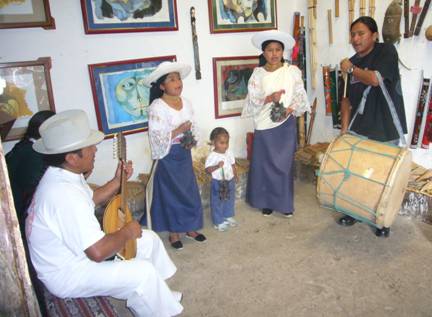
Nanda Manachi family musicians
Then it was time for the long drive to Machachi, which, with the developing rain and large amount of traffic, was not such a pleasant journey.
We arrived at about 6 o’clock at the delightful family run family hotel, hoping for sun in the morning.
Our evening meal was enjoyed sitting upstairs in this attractive ‘hosteria’.
Thursday 18th January A glacial lake walk and a rural market
There was rain throughout the night, but it had stopped by morning.
We left at 8 o’clock – me wearing my new cardigan bought at the market, and which was much admired.
We stopped in the village (Aloasi), for people to get water, and wandered across the typical Spanish square to the church.
We could see Corazon (Heart) mountain, with fresh snow on the top.
Diego explained about the ‘parano’, or alto plano – the high altitude grasslands, which trap moisture and so provide a water supply for drinking and irrigation. He told us that 15% of land in Ecuador is irrigated.
We stopped to photograph the double peaks of Iliniza mountain before entering Cotopaxi National Park, one of 9 in Ecuador, and the first to be opened in mainland Ecuador, in 1972 (the Galapagos NP dates from 1959).
We were driven for half an hour on an unsurfaced road before we stopped briefly by a small museum where there was a stuffed condor – we could see how huge they are. Outside there were a couple of white tailed deer.
We were now at over 12,000 ft, and stopped to have a delightful walk around Limpiopungo Lake. It looked very small at first, but looks were deceptive, and we had to do a ‘quick march’ at the end.
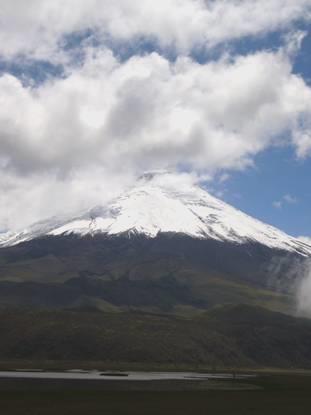
Cotopaxi
We saw lots of tiny flowers – gentians and a type of aster. The birds we saw were brown bellied swallows, variable hawk, yellowlegs, lapwing and Andean gulls. There were wild horses too. We could see snow capped Cotopaxi Mountain, and as we walked around, the top actually cleared. Every year 3,000 people try to climb the mountain, only 30% of them succeeding.
They start at midnight and walk for 8 hours to the summit, then walk the 4 hours down. The last eruption of Cotopaxi was in 1871 (but according to history, one is now due).
We were driven back to the road, and on to Saquisili, where we walked around 3 of the 10 large market areas. These were very much local markets, selling mostly fruit and vegetables, including many varieties of potatoes. I was glad to see manioc (cassava) and alfalfa, which I remember learning about at school.
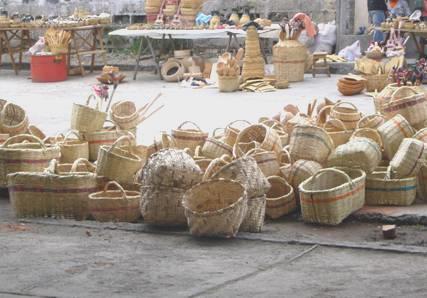
Local made baskets in Saquisili Market
We were driven on to a lovely 17th century hacienda for lunch. I had avocado with prawns and Adrian had trout. After lunch we had a wander around the attractive gardens.
We continued to Baños – a 2 hour drive, passing the town of Ambato, where Diego’s family live. Ambato was devastated by an earthquake in 1949, but rebuilt, and from 1951 a 4 day Carnival is held just before lent, featuring floats of fruit and flowers.
The weather had now deteriorated, so we couldn’t see Tungurahua volcano, which erupted last year in July and again in August, but just before we got to Banos, we had to travel over 2 pyroclastic flows, which had buried the road. We were all amazed to see the devastation they had caused.
We had driven through the town of Pelileo, which has become famous in recent years for producing blue jeans.
By the time we reached Baños, it was raining heavily. This was unfortunate, as we all had to walk through the streets to the hotel, so that Diego could point out things of interest for today, and for Monday, when we return from the Amazon Basin. Therefore we all arrived at the hotel soaked, but only had a short time to sort any washing we wanted done, as this is one of the few opportunities for this!
What was worse, all the restaurants which Diego had recommended were a long walk away. It was a nice surprise to come downstairs, armed with umbrellas, to find that the hotel did have a restaurant, and they beckoned us in. Two other couples joined us, and we spent a pleasant evening, even if the food wasn’t up to much. When we looked outside afterwards, the sky was clear and we could see Orion in the sky and the local waterfall lit up.
Friday 19th January Down to the Amazon basin
The morning was dry. We left at 8.30, stopping in the town to look at the sugar cane stalls. We sampled a juice made from the sugar cane, and also the spirit – firewater. Adrian liked the ‘toffee’ we tried, and bought some.
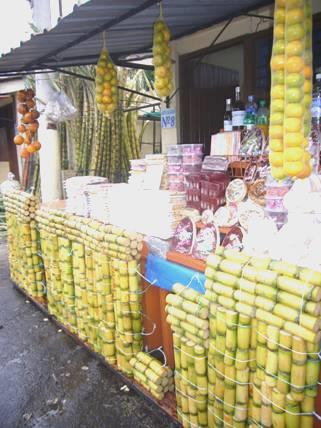
Sugar cane and products, Banos
The scenery was dramatic as we followed the gorge of the Pastaza River. We stopped by a lovely waterfall (Bridal veil!), where local kids had a ride across the deep valley in an open cable car. We could see 2 American kestrels close by on the wires.
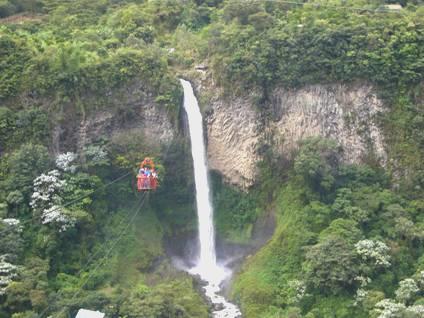
Kids enjoying a ride by the Bridal veil falls
We drove through several unlit tunnels as we followed the steep valley. Until recently the road had been narrow and unsurfaced.
We reached the town of Rio Verde and walked down steeply to view a raging waterfall called the Devil’s Cauldron. After getting watered by the spray, we braved it and walked across the river on a Capilano type suspension bridge. We made the long ascent back up, and just as we got back onto the bus it began to rain.
We reached Rio Negro village, at 4,000ft, where the cloud forest ended, and the tropical rain forest began, as we descended further towards the Amazon basin. Beautiful large pale mauve orchids lined the road.
At Puyo we stopped to visit a balsa wood factory, and watched the people carving and painting brightly coloured parrots and other figures. In the shop we bought several attractive and inexpensive articles.
Afterwards we had lunch in yet another attractive hosteria.
From here onwards, the road was unsurfaced, so the going was slow. They were widening and surfacing the road, and when we reached the roadworks, the going was even slower. We crossed several narrow ‘oh my God bridges’, without any sides. After an hour and a half, we reached Santa Clara, where we stopped briefly. After this, the road was mostly surfaced. We could look down to the Amazon basin, and see Sumaco volcano in the distance.
We saw several black vultures, and a blue and grey tanager. Diego told me that this was a subspecies from the one we saw at Mindo, and was more brightly coloured. We also saw a ruddy ground dove and a smooth billed ani.
We crossed the wide Napo River on a suspension bridge. The people of the Misahualli area are Indians from the highlands. The tribes originally settled here 500 years ago when the Spanish invaded.
At 5 o’clock we reached El Jardin Aleman, where we will be staying for 3 nights while we explore the Amazon basin. It is set in wonderful grounds, with monkeys, parrots and a toucan to amuse us.

The toucan investigates the contents of my bag
We were offered a drink of juice made from leaves, with the addition of firewater. We wandered through the grounds to our ‘room’ – set in a row of 3, with a veranda outside, with deck chairs and a hammock. We sat enjoying the atmosphere with our neighbours – Carol and Doug & Barry and Graham. It was really humid, so we both refreshed with a shower, before applying the detested mozzie spray. We had a short walk around and down to the Misahualli river before darkness fell.
Supper was eaten outside, under a roofed open building. There were 4 courses, so we were pretty full when we made our way back to our room.
Saturday 20th January Two Amazon rainforest walks
We heard heavy rain in the night, but awoke early to a dry morning. We both walked down to the river, and then around the grounds before breakfast. An amusing sight was to see one of the monkeys picking fleas from the small resident dog.
After breakfast, we all set off, wearing wellies (provided) and carrying ponchos in case of heavy rain (we didn’t have any). We left soon after 9 o’clock, and didn’t return until 1.00 pm.

Off for a walk through the Amazon rainforest
The walk was through secondary rainforest, and was extremely muddy (hence the boots). We climbed up to a ridge, and later back down again, but at the top we climbed through 2 separate ‘labyrinth’ sections, between steep rocks, which would have been no good if you were fat! The little dog followed along with us.
As well as Diego, we had a local chap called Henrico with us, and they pointed out the plants of interest. Because of the steepness, and the mud, everyone was given a stick to walk with, but we had our own.
We started by walking through the grounds, passing the coati and the agouti, and being shown several plants – Calliandra with its pink tufts, red justicia ancantasia, malvaticisus – like an unopened red hibiscus and yellow pachystachys lutea.
Some of the jungle plants we saw were white jungle onion, the root of which is used for stomach ailments, tagua – a house plant like palm, and the palm which is used for making panama hats. We saw a huge snail and a thin chonta snake.
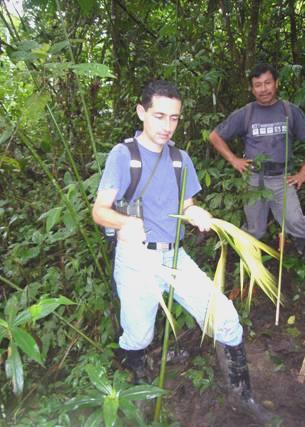
Diego shows us ‘panama hat’ palm fronds
We returned hungry and muddy, so after having our boots washed off, we had a shower before eating our 4 course lunch at the same outdoor seating area.
At 3.30 we set off on another walk, starting at a small village a 10 minute drive away. This time our waterproof ponchos were needed, as it began to rain heavily. The ponchos were heavy, and made me think of old army groundsheets. We looked an odd group, walking along in our long blue capes!
We began the walk by crossing the Misuahalli River on a dodgy looking suspension bridge, and then walked in a circle on the opposite bank to the lodge. It was still pretty mucky underfoot.
We saw a huge ceiba tree (kapok), like we had seen near Veracruz in Mexico. I photographed the manioc plants which are used here as a staple crop.
Henrico knocked down a cacao fruit, and we all tried sucking the fruits inside – they tasted more like lychees than chocolate at this stage.
We saw coffee and bananas plants – Ecuador, Colombia and Costa Rica are the 3 major exporters of bananas, but coffee has become too uneconomic to grow.
We saw crested oripendulas and their long hanging nests, and a yellow rumped asica.
Back at the lodge, after making our way to our room, we returned to try out the jacuzzi. The water wasn’t very warm, but we were entertained by the bushy monkey, who came beside the pool and amused us with its ‘naughty child’ behaviour, while the spider monkeys played on the upper floor, and the toucan sat in a nearby tree.
Another pleasant outside supper.
Sunday 21st January Canoe ride to another walk in the Amazon rainforest
After a short bus ride to Misahualli – a village where capuchin monkeys live in the square, we boarded two motorised canoes for a ride down the Napo River. The Misahualli River joins the Napo at this point, which flows on to join the Amazon River in Peru. Being Sunday, quite a few people were enjoying swimming in the river.
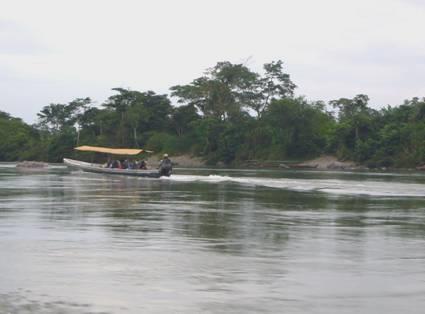
Down the Napo River
After ¾ hour, we got out of the canoes, and climbed up a steep and muddy path to a circular ‘hut’, which we returned to over 3 hours later for lunch.
So at 10 o’clock we set of on a circular walk through primary rainforest (unlogged), led by local shaman and guide Atahualpa and Diego. The going was often VERY muddy and steep, but I surprised Adrian and myself by managing it all.
We were shown a lot of the trees and plants, including Lecytidacia, a relative of the brazil nut, with nuts which grow directly from the trunk.
We climbed through a partly hollow fig tree and viewed fruit bats living up inside. We peeped into a hole and saw a tarantula spider. We saw the hole high up in a tree trunk where owl/night monkeys live. We had a go at playing Tarzan, swinging on some lianas (vines) hanging from the tall trees.
Atahualpa showed us some huge conga ants, but unfortunately got bitten by one. The sting is supposed to be worse than a bee or wasp sting. He searched for a particular leaf to use the sap to heal it – a bit like finding a dock leaf for stinging nettles, but declined Adrian’s offer of antihistamine.
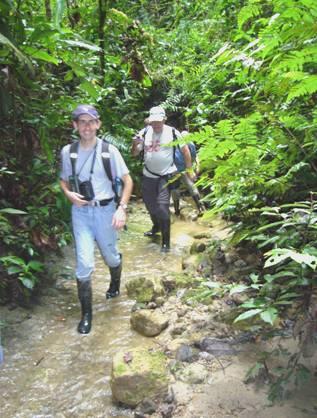
Negotiating a muddy stream
After some amazingly taxing uphill and downhill stretches, and a wade through a stream (wellies were essential, but one of mine had a hole in it), we arrived back at the circular seat for lunch. This was a meat, pea, bean, rice mixture, served in individual ‘billies’, and was warm! It was very welcome, but there was more than I could eat.
There was a loo down the track – a rectangular wooden ‘box’ in a doorless wooden hut!
We splodged back down to the canoes, where we began our ride back, stopping by the shore for Atahualpa to ‘pan for gold’. This was more authentic than anything we have seen before – he scrabbled in the ‘beach’ (with his good hand) and panned the mixture in a wooden dish, ending with a few specks of gold. It seems the locals, especially when they have to buy their children new school uniforms, all go gold panning. The going rate is about $8 per gram, so they must have to do a lot of panning to save up the estimated $60 per uniform.
Just before arriving back at Misahualli, we stopped at another small village, Muyuna, where a lady showed us how to pound manioc, mix it with another root and add water to make chichi, the local brew. We all had a taste – it was a bit like the Kava we’d tried in Fiji.

Girls carrying babies in Muyuna village
In one of the huts there were necklaces and bracelets made out of beads by the local children. Only 25 families live in the village, but families are large – average 8 children, and the older ones look after the younger ones and babies. Children seemed to learn responsibility early – Atahualpa’s young nephew had come with us on the canoe, and helped with the boat and food. (he also enjoyed a swim in the river – in his shorts, socks and shoes!)
After our short bus ride back, we were greeted with tea and cake at the lodge, which was very welcome. It was nice to take our wellies off! The sun had come out, and even having a shower didn’t cool us down, but it had been a really good day.
After our usual pleasant outside meal, Diego asked us to go across to the bar area for a briefing. The Danish group who are staying here had tried to hold their briefing during supper, and had asked us to be quiet. Several of them were smoking, which irritated us, so we asked Diego to speak to the leader and ask them to stop, which they did.
Diego told us of the next few days itinerary, and then dropped the bombshell – because of road works on the road back to Baños, the road would be closed from 8.00 am until midday. We would therefore be leaving at 6.00 am, getting up at 5.15!
Instead of a nice relaxing evening and morning, we made our way back to get sorted for our early rise! The sky had been clear and we had seen Orion at suppertime, but by bedtime it was cloudy, and in the night it rained heavily.
Monday 22nd January Back to Baños and a soak in the baths
It rained heavily again just as we were leaving at 6 o’clock. I dozed for most of the way to Puyo, despite the rough road. We had been given 2 rolls each for breakfast, but I didn’t eat mine until later. At Puyo we stopped at the same hosteria restaurant as before, and had welcome coffee/tea and toast.
As we continued to Baños, Diego told us something of sport in Ecuador, particularly about football, their main spectator sport. He told us of the former low esteem of Ecuadorian people, and how it had been built up through football, especially by the theme of ‘We can do it’, which has become their password. One player, de la Cruz, now plays for Reading. Another team is called Barcelona, after being started by Spanish immigrants.
The other important sport is Equavolleyball, played over a high net. We had seen that being played in the Amazon villages. He also said that the new President, who it is hoped will be a president for ‘the people’ has probably come out of this new optimism.
It was unfortunately raining for most of the journey back to Baños. Diego had planned a walk from a viewpoint just before Baños, right down into the town. We reached the viewpoint, at Runtun, above the Yuba River, but could see nothing at all. This was very disappointing. Some of the gallant group decided to go on the walk whatever, but as it was already raining hard, we opted out.
We had stopped in the rain to photograph the pretty pink cattlya orchids which we had seen on the outward journey. We now saw delightful white orchids too.
We arrived back at Hotel Volcan at 11.45, and got settled back into our previous rooms.
We both soon set off for the nearby thermal baths, where we soaked in the warm yellow water, along with lots of locals. One little baby girl was just loving the water. We were surprised at how many babies were taken to the baths.
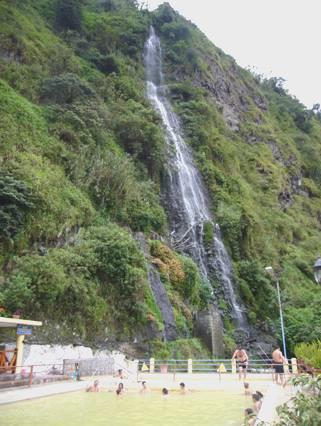
A lovely setting for Banos thermal baths
After this we walked around the town, stopping to view the attractive but ornate cathedral church, site of pilgrimages because of the supposed miracles which have happened, attributed to the Virgin Mary.
We were able to use the internet and send a message to our kids. Tom told us that he was apparently on BBC3 this week – filmed when he was teaching in London. Simon told us of Manolo’s continuing delight in cars.
After finding an ATM to get some more cash, we had a pleasant late lunch in ‘Hoods’ – cheese and tomato on toast with a glass of wine ($2.50 each).
We stopped to buy a few things in the supermarket, as it is planned that we have a picnic lunch tomorrow. We found booze ridiculously cheap, and so bought some wine and rum.
Back at the hotel, I went down for a pleasant swim in the pool, with the steep volcanic slopes up behind.
In the evening we walked up to Mariane’s, where almost all the group ended up, and enjoyed a very nice meal.
Tuesday 23rd January A broken coach and the highest mountain in Ecuador
We left on the bus at 8.30 for Riobamba. Once again we had to drive over the pyroclastic flows from last year’s eruption.
The visibility was clearer today, so we were able to see some of Tungurahua volcano.
In the valley where we stopped to view the mountain, tangerines were being grown, and there were also maize fields, the maize being used as food for the chickens in the adjacent farm.
We were driven back to Pelileo, the blue jeans town, where we circumnavigated the market, then stopped at a bakers to get rolls for lunch.
When we returned to the coach, Danilo was relaxing in his driver’s seat. A few minutes later he had a different look on his face, as the warning light came on and he pulled over, to find that there was a hole in the radiator, and all the water had leaked out!
Diego was quick to try to sort things out, and after an hour, we all boarded another bus which would take us to Riobamba, where a different bus would be sent down from Quito. We had lost very little time, but the sad thing was that we had to say goodbye to Danilo before we were prepared to.
We were now driven up the Quero valley, which was a fruit growing area. We drove past the village of Mocha to Urbina, the highest station on the railway from Quito to Guayaquil.
At the station, we saw how carving is done from palm nuts – the result looking rather like ivory. I bought a knitted Ecuadorian hat here, then we all had our picnic lunch sitting in the now defunct station building. Outside there were llamas and a shaggy alpaca.
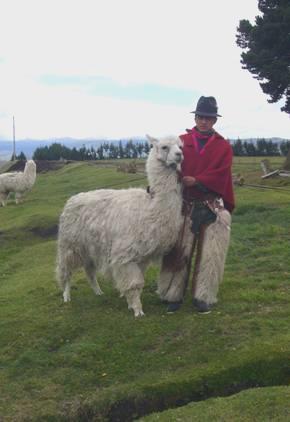
Local with an alpaca
We continued on our way to Riobamaba, arriving at the ‘Monte Carlo’ hotel in the centre of the large town at 2 o’clock.
The other coach soon arrived, so after taking our things to our rooms, we set off again to drive to Chimborizo Volcano – an extinct volcano and the highest in Ecuador.
We had a new driver called Galo, and soon we were driving out of the town and heading for the volcano. Yesterday we were at 400m and today we were driving to over 4,000m. We began to feel the affects of the altitude at 4300m (14,100ft) – tiredness, shortness of breath, and slight head and stomach aches. Explore used to go even higher – to 5,000 metres at the base camp, but several people became unwell at this altitude.
We stopped with a lovely view to the snow and glacier topped mountain, and took several photos.
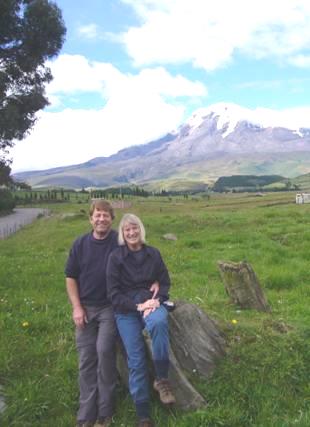
Us by Chimborazo Volcano
In the field opposite, a group of people were harvesting potatoes. Diego told us that everyone mucks in, not just the family who own the field, and a celebratory meal is held afterwards.
We saw several groups of vicunas (a bit like llamas), which had been reintroduced in the 90’s. Low growing lupins were growing in the fields. We could see the clouds rising up from the valley.
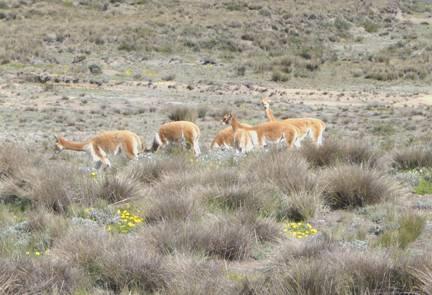
A group of vicunas
We stopped to photograph the interesting rock strata. Pretty yellow bidens were growing from the inhospitable looking ground.
We stopped to walk down to the scattered village of Polinqui. The villagers here grow barley, broad beans and potatoes – nothing else will grow at this high altitude.
We watched a group of alpacas before walking past the humble thatched dwellings. A new school has been built here, with the hope of educating the children to be able to continue living in this high altitude village.
As we drove back towards Riobamba it was slow going, as all the animals – cows, donkeys, pigs and dogs were being led back from their daytime pastures by adults and often by young children.
We arrived back at the hotel at 6.15, and met at 7.00 for Diego to tell us that tomorrow we have to be up at 4.45!
We all walked out to an attractive traditional restaurant, where we were entertained by a local band (including the chap who had demonstrated the carving to us earlier). The food was a long time coming – something about an accident in the kitchen – but it was a convivial evening, and we didn’t get back until 9.45pm.
Wednesday 24th January A rooftop train ride before descending to Guayaquil
The reason for our extra early wake up was that today is the day for us to ride on the ‘Devil’s Nose’ train. Well, not actually a train – because of mud and rocks falling due to the rainy season, the actual train isn’t running. Instead, an ‘autoferro’ – a sort of bus which runs on the rails, is running instead. Places on it are limited, but Diego ‘had his contacts’ and had managed to get us tickets. Last night a chap had signalled to him while we waited at a red traffic light, jumped on the bus, handed him some tickets, and jumped off again as the bus sped off!

The autoferro, ready to leave Riobamba
By 5.45am we were waiting at the station, having had a rushed early breakfast. The train didn’t leave until 6.30. We had debated whether to sit ‘on top’ – the thing to do, or inside. Only 20 can sit on top, and as there seemed to be that number waiting already, we opted to sit inside, with the option of sitting on top for the shorter return journey. This we did. We weren’t sure anyway if my back would stand 3 hours sitting unsupported, even if I liked the elevated rooftop position.
The ‘train’ just descended down and down the valley, following the Chanchan River. It was lovely to look out to the locals, who nearly all waved, and to see the various crops being grown. We were amused that every dog we passed ran along beside the ‘train’ for as far as it could.
At 8 o’clock we stopped for a ‘loo stop’, and again at Alousi (2400m). The valley became very steep, but unfortunately it was really foggy – the first time that Diego had encountered fog in this area. I loved seeing all the different flowers growing beside the track – a brilliant crimson red 4 petalled one and an equally bright blue one. There were also a variety of different cacti, some of them in flower.
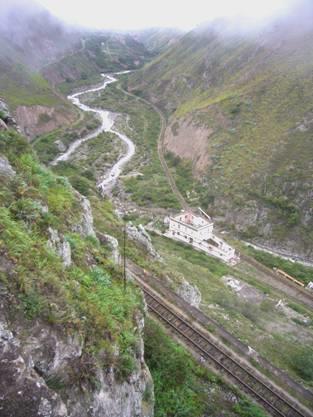
Part of the zigzag
After Alousi we descended the zigzag ‘Devil’s Nose’ section, but were rather disappointed that it was only a couple of zigzags – we thought that there would have been more.
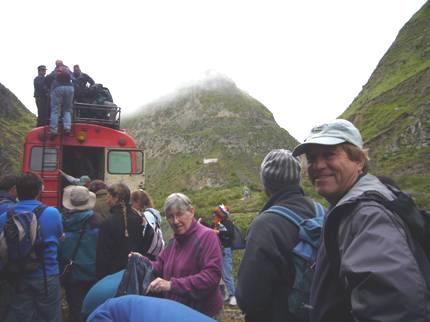
Waiting to go ‘on top’
When we reached the bottom, we had our chance to sit on top for the return journey to Alousi, 800m above. We were sitting on the ‘cliff’ rather than the vertical side, which was probably better for me! We did have some rain, but luckily arrived back before we were drowned.
It was now 11.00 am. We drove through the town and on to Huegro, actually called San Pedro de Huegro, where we stopped to have lunch in attractive Hosteria ‘Eternal Spring’. We noticed how much warmer it was here (although it was still 1800m). This town is also on the railway line from Quito to Guayaquil, and was important in the days of the railway, but there is no work now that the line has closed, except for tourist trips. Most men from the town work abroad – USA and Spain, and send money back to the family.
The railway line was started in 1899 and took 9 years to build. There were many problems with the workers, and consequently lots of West Indian immigrants helped with the work.
As we continued descending to the coastal area, the weather was still foggy and then wet, with lots of fallen rocks. It became gradually warmer and more humid.
The coastal region we drove through was flat and less interesting. Very little remains of the original forest, as plantations of various sorts took over in the past. Now the area grows masses of bananas – the largest exporter in the world. There are also plantations of sugar, rice and mangoes.
As we neared Guayaquil it became more and more busy and unattractive, looking more western. The people here are more liberal than in the highlands, where tradition is still important.
We stopped briefly at a supermarket before continuing to our hotel – set on a busy corner in this vast and bustling city.
While we had supper, Trevor handed over our ‘tips’ to Diego for him and the drivers. He gave a nice little speech, and we all agreed what a fantastic leader Diego had been.
Then we had to go and sort out the things to take to the Galapagos tomorrow, and decide what would be left behind at the hotel to await our return.
Ecuador









